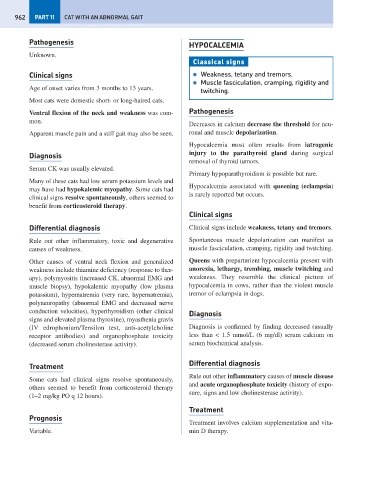Page 970 - Problem-Based Feline Medicine
P. 970
962 PART 11 CAT WITH AN ABNORMAL GAIT
Pathogenesis HYPOCALCEMIA
Unknown.
Classical signs
Clinical signs ● Weakness, tetany and tremors.
● Muscle fasciculation, cramping, rigidity and
Age of onset varies from 3 months to 13 years.
twitching.
Most cats were domestic short- or long-haired cats.
Ventral flexion of the neck and weakness was com- Pathogenesis
mon.
Decreases in calcium decrease the threshold for neu-
Apparent muscle pain and a stiff gait may also be seen. ronal and muscle depolarization.
Hypocalcemia most often results from iatrogenic
Diagnosis injury to the parathyroid gland during surgical
removal of thyroid tumors.
Serum CK was usually elevated.
Primary hypoparathyroidism is possible but rare.
Many of these cats had low serum potassium levels and
Hypocalcemia associated with queening (eclampsia)
may have had hypokalemic myopathy. Some cats had
is rarely reported but occurs.
clinical signs resolve spontaneously, others seemed to
benefit from corticosteroid therapy.
Clinical signs
Differential diagnosis Clinical signs include weakness, tetany and tremors.
Rule out other inflammatory, toxic and degenerative Spontaneous muscle depolarization can manifest as
causes of weakness. muscle fasciculation, cramping, rigidity and twitching.
Other causes of ventral neck flexion and generalized Queens with preparturient hypocalcemia present with
weakness include thiamine deficiency (response to ther- anorexia, lethargy, trembing, muscle twitching and
apy), polymyositis (increased CK, abnormal EMG and weakness. They resemble the clinical picture of
muscle biopsy), hypokalemic myopathy (low plasma hypocalcemia in cows, rather than the violent muscle
potassium), hypernatremia (very rare, hypernatremia), tremor of eclampsia in dogs.
polyneuropathy (abnormal EMG and decreased nerve
conduction velocities), hyperthyroidism (other clinical Diagnosis
signs and elevated plasma thyroxine), myasthenia gravis
(IV edrophonium/Tensilon test, anti-acetylcholine Diagnosis is confirmed by finding decreased (usually
receptor antibodies) and organophosphate toxicity less than < 1.5 mmol/L (6 mg/dl) serum calcium on
(decreased serum cholinesterase activity). serum biochemical analysis.
Differential diagnosis
Treatment
Rule out other inflammatory causes of muscle disease
Some cats had clinical signs resolve spontaneously,
and acute organophosphate toxicity (history of expo-
others seemed to benefit from corticosteroid therapy
sure, signs and low cholinesterase activity).
(1–2 mg/kg PO q 12 hours).
Treatment
Prognosis
Treatment involves calcium supplementation and vita-
Variable. min D therapy.

